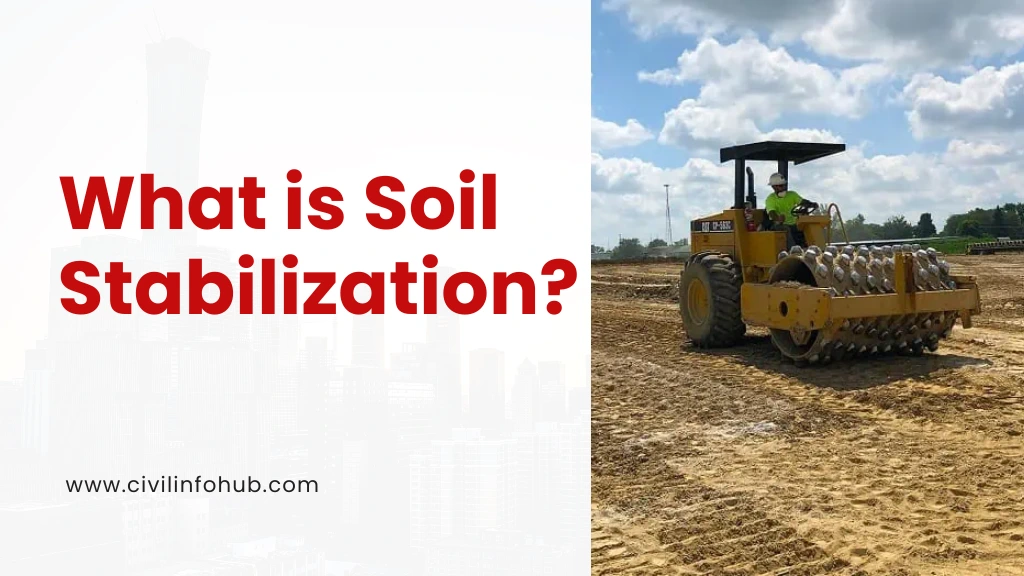Constructional, soil stabilization is one of the basic processes, through its physical and chemical properties. This simple enhancement will help strengthen the soil enough to take the structural loads, resist erosion, and serve as a base solid sufficient for roads, buildings, and airports. This is a cornerstone of civil engineering, in the area where the natural soil is unsuitable for construction.
In this guide, we’ll explore exactly What is Soil Stabilization, its purpose, its methods, and how it’s used in modern infrastructure projects. Civil Engineers, construction professionals, or just curious, it’s time to learn about soil stabilization.
Understanding Soil Stabilization
Soil stabilization at its core means changing the soil to a desired level of strength, durability, and stability. This is typically accomplished by compaction, or the addition of stabilizing agents such as lime, cement, or bitumen. Fabrics offer treated grains that enhance soil’s load-bearing capacity minimize erosion risks and improve drainage properties.
A case would be stabilization that transforms the soil in areas where it is too soft or weak to support heavy construction to a stable foundation which would negate the need to do an expensive soil replacement.
The Importance of Soil Stabilization in Construction
The construction world is not simply technical when it comes to soil stabilization, as it is necessary. Unstable soil can cause structural failure to occur, uneven settlements, and costly repairs. Stabilization makes sure that infrastructure is durable and is safe.
Key Advantages of Soil Stabilization:
- Enhanced Load-Bearing Capacity: Stabilized soil is capable of supporting heavy structures and traffic loads, without deforming.
- Durability: It enhances the soil’s capacity to resist the effects of rain and frost.
- Cost Efficiency: Thus, new materials do not need to be transported.
- Environmental Benefits: It uses local materials and cuts down on the project’s ecological footprint.
Applications of Soil Stabilization
This technology has its applications in different parts of the construction sector. Here are its primary applications:
- Road Construction: A strong subgrade is necessary for a road to cope with traffic loads. The stabilized soil forms a foundation for the pavement which lasts a long and the maintenance is less.
- Building Foundations: Structural instability can be caused by weak soil under a building. Stabilized soil forms not only a stable and uniform base for construction but also an option to use as fill.
- Airport Runways: Runways are stressed by aircraft. This results in soil stabilization to ensure that the subgrade can handle these loads, efficiently.
- Slope Protection: Stabilized soil is used on embankments and slopes for safety and durability preventing erosion and landslides.
- Industrial Applications: For most heavy-duty applications (e.g. storage yards, landfills, etc.), stabilized soil is used.
What is Soil Stabilization in Civil Engineering?
Soil stabilization is an important step in getting a reliable foundation for civil engineering work. However, soils that don’t possess enough strength or stability are often encountered by civil engineers. Using stabilization techniques, they can transform such soils into viable bases for construction.
Why It Matters in Civil Engineering:
- It helps in soil weakness which can undermine the integrity of a structure.
- Stabilized soil changes soil-related failures to a safer side.
- It practices sustainable construction using existing resources.
This stabilization is implemented for instance on highways and expressways, since it allows for stably smooth and lasting pavements in regions where the soils are hard to stabilize.
Methods of Soil Stabilization
Stabilizing soil is accomplished in several ways, all suitable for different types of soil, project needs, etc. Below are the most common methods:
1. Mechanical Stabilization
This involves the use of the compact blend involving the mixing of different types of soils to strengthen and stabilize the soils to the required degrees of strength and stability. To reduce void spaces and achieve high densities, roll, and compactors are used as heavy machinery.
2. Chemical Stabilization
In the soil, a chemical additive, such as lime, cement, or fly ash, is mixed in. The chemicals bond with those soil particles increase cohesion and reduce plasticity. For example:
- Lime Stabilization: It is best used in clay soils reduces swelling and improves workability.
- Cement Stabilization: Especially on sandy or silty type soils it adds strength.
3. Bituminous Stabilization
This is a binding agent, which happens in road construction such as bitumen. However, it’s flexible durable, and resistant to water and temperature changes.
4. Geosynthetic Reinforcement
Synthetic materials for geotextiles and geogrids are laid within or on top of the soil. Of particular importance for embankments and retaining walls, they increase tensile strength.
5. Biological Stabilization
Naturally, the plant roots can bind particles together as a way to stabilize the soil. Properly used, this method is used for slope protection and erosion control.
What is Soil Stabilization in Road Construction?
On the other hand, soil stabilization in road construction prevents the subgrade from deformation under the effects of heavy traffic loads. Stabilized soil is a resilient base for roads that must face constant pressure and constantly changing environmental conditions.
Techniques Used in Road Construction:
- Application to cohesive soils stabilized with lime.
- Strength enhancement by cement stabilization.
- Bituminous Stabilisation for Flexible Pavements.
Benefits of Road Projects:
- Increased lifespan of roads.
- Frequent repairs got easier.
- Wetter and tougher resistance to extreme temperatures.
For instance, in areas that receive high rainfall, bituminous stabilization prevents waterlogging and erosion making the driving surface smooth.
What is Soil Stabilization and Its Uses?
However, any construction project that involves having a strong foundation requires soil stabilization. However, it does much more than simply offer support; its uses reach far beyond and can help to cut costs, reduce environmental impact, and increase efficiency in any project.
Primary Uses:
- Building Strong Foundations: Stabilized soil can be used for all types of houses, bridges, and industrial facilities, and it can secure safety and durability.
- Improving Pavements: It builds up into highways, local roads, and better base layers.
- Erosion Control: Stabilized soil is resistant to water erosion so it preserves the slopes and the embankments.
- Sustainable Practices: Stabilization practices use local soil and minimal excavation and are therefore eco-friendly.
Conclusion
Modern construction relies heavily on soil stabilization as it attempts to resolve soil-related issues that may otherwise impair structural integrity. This process will help to stabilize and strengthen the soil while creating long-lasting, durable, and cost-efficient infrastructure.
There are various ways of stabilizing soil for roads, buildings, and slopes through chemical additions, mechanical compaction, or geosynthetics that give engineers a field of versatile techniques to improve the performance of soil. Additionally, the process is consistent with sustainable builds by minimizing waste and utilizing local resources.
Soil stabilization isn’t just about improved project results, it’s about making infrastructures safe and reliable, a cornerstone in civil engineering.
Read More: APCO Infratech Hiring 2025 | Road Project Job Openings | Apply Now
FAQs
What is soil stabilization in simple t terms?
Improvement of physical and chemical properties of soil to increase its strength and stability for construction projects is called soil stabilization.
What are the principal means of soil stabilization?
Mechanical stabilization, chemical stabilization with lime, cement, bitumen, and geosynthetic reinforcement are the main methods. Depending on the type of soil and project requirements, each method is chosen.
What is the importance of soil stabilization during road construction?
By strengthening the subgrade, soil stabilization can provide heavy traffic loading conditions, and various environmental conditions such as rain and frost, and minimize maintenance in the future.
How can we stabilize some of these soil types most effectively?
Stabilization is almost complete because virtually all types of soil can be stabilized clay, silt, sand, loam. The method and material used depend on the properties of the soil.
What role does soil stabilization play in sustainable construction?
A principle of soil stabilization is to minimize environmental impact and promote eco-friendly techniques of construction by using local soil and reducing the requirement for transportation or replacement materials.








